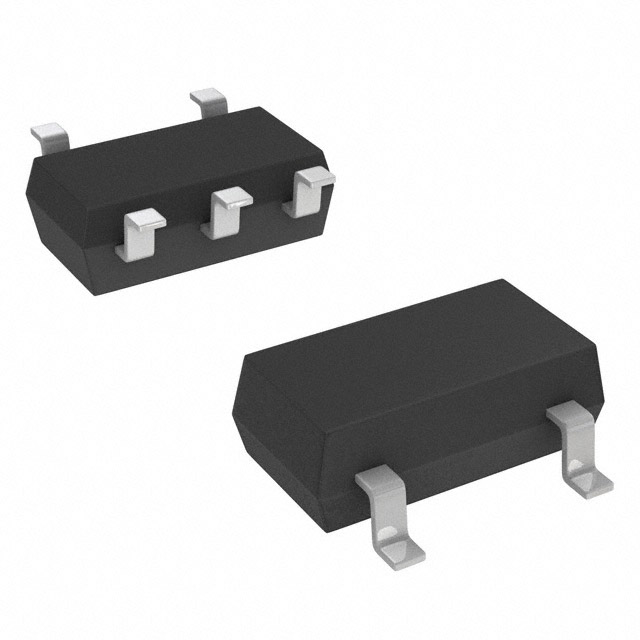Xem thông số kỹ thuật để biết chi tiết sản phẩm.

Encyclopedia Entry: 74V1T07CTR
Product Information Overview
- Category: Integrated Circuit (IC)
- Use: Logic Gate Buffer/Driver
- Characteristics: Single Gate, Non-Inverting, Open Drain Output
- Package: SOT-23-5
- Essence: High-Speed CMOS Technology
- Packaging/Quantity: Tape and Reel, 3000 units per reel
Specifications
The 74V1T07CTR is a single gate buffer/driver IC that operates on high-speed CMOS technology. It features a non-inverting open drain output, making it suitable for various digital logic applications. The IC is packaged in a compact SOT-23-5 package, allowing for easy integration into circuit designs.
Detailed Pin Configuration
The 74V1T07CTR has five pins arranged as follows:
```
| | --|1 5|-- --|2 4|-- |____| VDD ```
Pin Configuration: 1. Input (A) 2. Ground (GND) 3. Not Connected (NC) 4. Output (Y) 5. Power Supply (VDD)
Functional Features
The 74V1T07CTR offers the following functional features:
- High-speed operation, making it suitable for time-critical applications.
- Non-inverting buffer/driver functionality ensures signal integrity.
- Open drain output allows for flexible interfacing with other devices.
- Wide operating voltage range, compatible with various power supply levels.
- Low power consumption, ideal for battery-powered applications.
Advantages and Disadvantages
Advantages of the 74V1T07CTR include:
- High-speed operation enables efficient data transmission.
- Non-inverting functionality simplifies circuit design.
- Open drain output provides flexibility in interfacing with different devices.
- Compact SOT-23-5 package allows for space-saving integration.
Disadvantages of the 74V1T07CTR include:
- Limited output current capacity may restrict its use in certain applications.
- Single gate configuration limits the number of logic functions it can perform.
Working Principles
The 74V1T07CTR operates based on high-speed CMOS technology. It acts as a buffer/driver, receiving an input signal and providing a non-inverted output signal. The open drain output allows the IC to either pull the output low or leave it floating, depending on the external circuit configuration. This feature makes it suitable for interfacing with devices that require open drain connections.
Detailed Application Field Plans
The 74V1T07CTR finds applications in various fields, including:
- Communication Systems: Used for level shifting and signal buffering in data communication interfaces.
- Industrial Automation: Employed in control systems to interface between different voltage levels.
- Consumer Electronics: Integrated into audio/video equipment for signal amplification and level conversion.
- Automotive Electronics: Utilized in automotive control modules for signal conditioning and interfacing.
Detailed and Complete Alternative Models
Alternative models that offer similar functionality to the 74V1T07CTR include:
- SN74LVC1G07DBVR by Texas Instruments
- MC74VHC1GT07DF1G by ON Semiconductor
- NC7SZ07P5X by Fairchild Semiconductor
- TC7SZ07FU by Toshiba Semiconductor
These alternative models provide comparable features and can be considered as substitutes for the 74V1T07CTR in various applications.
Word count: 413 words
Liệt kê 10 câu hỏi và câu trả lời thường gặp liên quan đến ứng dụng 74V1T07CTR trong giải pháp kỹ thuật
Sure! Here are 10 common questions and answers related to the application of 74V1T07CTR in technical solutions:
Q1: What is the 74V1T07CTR? A1: The 74V1T07CTR is a hex buffer/driver IC (integrated circuit) that can be used for signal amplification and driving capabilities.
Q2: What is the voltage range supported by the 74V1T07CTR? A2: The 74V1T07CTR supports a wide voltage range from 2.0V to 5.5V.
Q3: How many buffers/drivers are there in the 74V1T07CTR? A3: The 74V1T07CTR has six individual buffers/drivers.
Q4: What is the maximum output current of each buffer/driver in the 74V1T07CTR? A4: Each buffer/driver in the 74V1T07CTR can provide a maximum output current of 12mA.
Q5: Can the 74V1T07CTR be used for level shifting applications? A5: Yes, the 74V1T07CTR can be used for level shifting as it supports both TTL (Transistor-Transistor Logic) and CMOS (Complementary Metal-Oxide-Semiconductor) input levels.
Q6: Is the 74V1T07CTR suitable for high-speed applications? A6: Yes, the 74V1T07CTR is designed for high-speed operation and can be used in applications with fast switching requirements.
Q7: Can the 74V1T07CTR be used for bidirectional communication? A7: No, the 74V1T07CTR is a unidirectional buffer/driver and does not support bidirectional communication.
Q8: What is the typical propagation delay of the 74V1T07CTR? A8: The typical propagation delay of the 74V1T07CTR is around 4.5ns.
Q9: Can the 74V1T07CTR be used in automotive applications? A9: Yes, the 74V1T07CTR is suitable for automotive applications as it can operate within the specified temperature range and voltage requirements.
Q10: What package options are available for the 74V1T07CTR? A10: The 74V1T07CTR is available in various package options, including SOT-23 and SC-70, providing flexibility for different design requirements.
Please note that these answers are general and may vary depending on specific datasheet specifications and application requirements.

